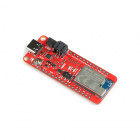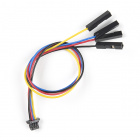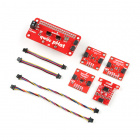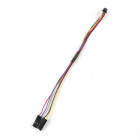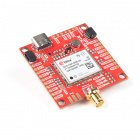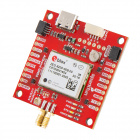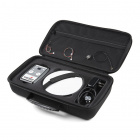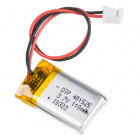Contributors:
santaimpersonator, MAKIN-STUFF
Introduction
The SparkFun Thing Plus - DA16200 utilizes a highly integrated ultra-low power WiFi system on chip (SoC) that allows users to develop WiFi and IoT solutions.
WRL-19696
The SparkFun DA16200 Thing Plus utilizes a highly integrated ultra-low power WiFi system on chip that allows users to develop…
Manufactured by Dialog (a subsidiary of Renesas), the DA16200MOD contains a 802.11b/g/n radio (PHY), a baseband processor, a media access controller (MAC), on-chip memory, and a host networking application processor, all on a single silicon die. The SoC has full offload capabilities to run the entire networking OS and TCP/IP stack on chip; therefore, an external network processor, CPU, or microcontroller are not required. The module is also Wi-Fi Alliance certified for IEEE802.11b/g/n, Wi-Fi Direct, WPS functionalities in many countries including the United States (FCC), Canada (IC) and China (SRRC).
This board comes in a Thing Plus form factor, which includes a Qwiic and LiPo battery connectors, multiple GPIO pins, and JTAG PTH pins for debugging. The SparkFun Thing Plus - DA16200 is ideal for your next IoT project, thanks in part to the multiple sleep modes that allow you to take advantage of current draws as low as 0.2 - 3.5 µA on the WiFi module.
Note: Please be aware that the Thing Plus - DA16200 has a 3.3V logic level voltage.
Required Materials
To get started, users will need a USB-C cable is needed to connect the DA16200 Thing Plus to a computer. (You may already have a some of these items; read through the guide and modify your cart accordingly.)
CAB-14743
USB C is fantastic. But until we have converted all our hubs, chargers, and ports over to USB C this is the cable you're goin…
WRL-19696
The SparkFun DA16200 Thing Plus utilizes a highly integrated ultra-low power WiFi system on chip that allows users to develop…
Optional Hardware
To connect Qwiic breakout boards for your project, Qwiic cables are required.
KIT-15081
To make it even easier to get started, we've assembled this Qwiic Cable Kit with a variety of Qwiic cables from 50mm to 500mm…
CAB-17261
This polarized I2C cable insulation is made from silicon making it more flexible than our original Qwiic cable particularly i…
KIT-21285
The SparkFun Qwiic Kit for Raspberry Pi includes a shield with headers, three Qwiic-enabled breakout boards, and four cables …
CAB-22726
This is a jumper adapter cable that comes pre-terminated with a female Qwiic JST connector on one end and female connectors o…
GPS-16481
The SparkFun GPS-RTK-SMA raises the bar for high-precision GPS and is the latest in a line of powerful RTK boards featuring t…
GPS-19984
The SparkFun RTK Facet is a fully enclosed GNSS receiver for centimeter-level positioning. Perfect for high precision geoloca…
GPS-28871
The SparkFun Allband GNSS RTK Breakout - ZED-X20P (Qwiic) features the latest GNSS engine from u-blox; the X20, which is a su…
GPS-18380
The RTK Express Kit has everything you need to get centimeter level global positioning measurements using GNSS RTK.
A single-cell Lithium-ion battery can be connected to the DA16200 Thing Plus for portability.
PRT-13853
This is a very small, extremely light weight battery based on Lithium Ion chemistry. This is the highest energy density curre…
PRT-13851
This is a very small, extremely lightweight battery based on Lithium Ion chemistry, with the highest energy density currently…
PRT-13855
These are very slim, extremely light weight batteries based on Lithium Ion chemistry. Each cell outputs a nominal 3.7V at 200…
PRT-13813
Slim, extremely light weight batteries based on Lithium Ion chemistry. Each cell outputs a nominal 3.7V at 1000 mAh!
Retired
To modify the jumpers, users will need soldering equipment and/or a knife.
TOL-09325
This is your basic spool of lead free solder with a water soluble resin core. 0.031" gauge and 100 grams. This is a good spoo…
TOL-14579
This 10mL no-clean flux pen from Chip Quik is great for all of your solder, de-solder, rework, and reflow purposes!
TOL-09200
It's like an Xacto knife, only better. We use these extensively when working with PCBs. These small knives work well for cutt…
TOL-14228
The WLC100 from Weller is a versatile 5 watt to 40 watt soldering station that is perfect for hobbyists, DIYers and students.…
Retired
Suggested Reading
For users who aren't familiar with the following concepts, we also recommend reading the following tutorials before continuing.
Serial Communication
Asynchronous serial communication concepts: packets, signal levels, baud rates, UARTs and more!
Logic Levels
Learn the difference between 3.3V and 5V devices and logic levels.
I2C
An introduction to I2C, one of the main embedded communications protocols in use today.
Analog vs. Digital
This tutorial covers the concept of analog and digital signals, as they relate to electronics.
Serial Terminal Basics
This tutorial will show you how to communicate with your serial devices using a variety of terminal emulator applications.
How to Work with Jumper Pads and PCB Traces
Handling PCB jumper pads and traces is an essential skill. Learn how to cut a PCB trace, add a solder jumper between pads to reroute connections, and repair a trace with the green wire method if a trace is damaged.
ARM Programming
How to program SAMD21 or SAMD51 boards (or other ARM processors).


